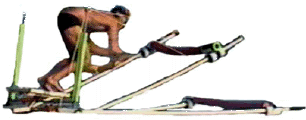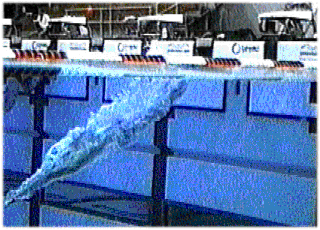
Privacy, Copyright and Content Policies
Best if viewed with Internet Explorer 5.0 or higher.

Safety Awareness
| Proper instruction and safety awareness should be established prior to using a starting block. |
Safety is our most important concern at PowerStarts®. Our techniques put the swimmer farther out across the pool, higher over the water, and with significantly higher entry speeds than they are likely used to. Consequently, additional safety measures must be observed as you develop these techniques.
Doing any kind of start requires a certain amount of skill.
There are many shallow pools around the world that are used for competition. You may be used to practicing starts in a pool that is deeper than a pool where a competition is held. Competing in a different pool, it may not be obvious to you at first that you may have to change your technique.
DO NOT ATTEMPT ANY OF THE TECHNIQUES DISCUSSED ON THIS SITE IN LESS THAN 7 FEET OF WATER!! Only when you have mastered the techniques is it prudent to even consider applying them to shallower pools.
"Based on depth values alone, the recommended depth of a racing diving pool should be greater than 1.4 meters for experienced divers". (Recommendations to the NCAA from a study by Gale M. Gehlsen and John Wingfield at the Biomechanics Laboratory, Ball State University, Muncie, Indiana.)
|
Any swimmer using a racing-technique-start from a starting-block has the potential to strike the bottom of the pool with sufficient force to cause catastrophic cervical spine injury. |
PowerStarts® TechniquesTM
Understand that applying more height to your dive will result in a tendency to dive deeper after entry. A key component of the PowerStarts® TechniqueTM is the post-entry "steering" that prevents the swimmer from diving deep and turns the additional height-energy into forward thrust.
Underwater steering forces (arms over the head, head up, back arched, hands flat) can easily direct the body in trajectories that will avoid contact with the bottom of the pool and should be taught as a skill during swimming instructional programs. It is important that safety-awareness be taught to help prevent diving injuries.
Newton's Law of Action and Reaction means that if you jump higher than usual you will also go deeper than usual, unless you do something to change your direction upon entering the water.
 |
Fact: Swimmers even hit the bottom of the pool in deep water (greater than 2 meters) when they execute a dive that is too deep. (Photo courtesy of Coach Scope). |
There's no joy in smacking into the bottom of the pool.
| Fact: There are approximately 28,500 water entry (diving) injuries annually. |
Scary?
Are we trying to scare you? Yes!
Swimming in general, and competitive swimming in particular, can be tremendously enjoyable and rewarding activities. However, like all physical activities, the swim start must be given the care and respect it deserves. With the proper training and appropriate precautions, you can become a much better starter without being dangerous.
Regardless of depth of pool or height of starting block, use of starting-blocks should be limited to competitive and instructional situations, and proper teaching progressions should be established.